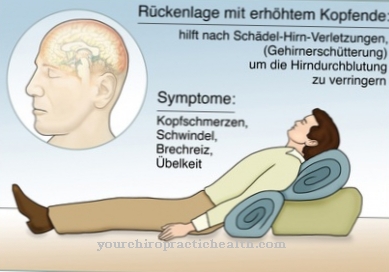sunburn or Solar dermatitis is an inflammation of the skin. Typical signs are reddened skin, itching and blisters. Sunburn has a lasting effect on the skin, causes it to age faster and forms more wrinkles. Likewise, severe sunburn can lead to skin cancer in the long term.
What is sunburn?

sunburn is also known in medicine as dermatitis solaris or light dermatosis. In the case of sunburn, the skin is burned by the ultraviolet radiation of the sun.
Sunburn can be divided into first and second degree burns. Sunburn damages the skin permanently and irreversibly and leads to inflammation and cell damage, which can potentially also lead to skin cancer.
causes
The causes for sunburn are well known. Too long and too strong exposure to the sun or exposure to the sun on the skin can cause sunburn. The ultraviolet rays emanating from the sun are particularly responsible for this.
Although the skin itself has protective mechanisms and can repair inflamed skin by itself, if the UV radiation is too strong, it is not enough to protect the skin completely from the sun. The pigments in the skin play a particularly important role. The more pigments a person has, the higher their natural protection against solar radiation. Therefore, particularly fair-skinned people are at risk of getting sunburn, whereas Africans can usually have a higher level of sun exposure without getting sunburn.
In summary, the following causes of sunburn can be found:
1. Too long and intensive unprotected sunbathing
2. Insufficient protection of the skin through self-protection (pigments), clothing or sun cream (sun protection factor)
3. Increased exposure to sunlight through water and snow (e.g. when sailing or skiing)
4. Indirect solar radiation in the shade through reflection (e.g. under a parasol on the beach)
5. Some medications, such as antibiotics and essential oils, can cause increased sensitivity to light
Symptoms, ailments & signs
The first signs of a sunburn are often overlooked or not even considered possible because they were not expected. An unusually long stay in nature in the sunshine on a hike or bike ride is enough. Suddenly it is noticed that the skin is reddened and tight, even though you haven't really sunbathed.
It is enough to keep your arm out in the car with the window open, suddenly your skin is taut. Depending on the skin type, the reaction is correspondingly violent. If the reddening of the skin is overlooked as the first sign of sunbathing, skin burns can occur, the skin swells and becomes hot. Usually, and depending on the condition of the skin, the first signs can be seen after about four to six hours.
The symptoms are strongest after about 12 to 24 hours. Then the pain begins, which is very uncomfortable with a sunburn. Touching burned areas of skin is very painful. As the sunburn progresses, the skin blisters and hurts without touching it.
When the skin begins to peel off and the burned areas begin to itch, the healing process begins. If large areas of skin are burned, nausea, vomiting and fever can occur. Headaches and circulatory problems accompany extensive sunburn.
Course of disease
The course of sunburn develops from increased exposure to sunlight. However, the typical symptoms can only be seen and felt later, about 6 to 8 hours. The peak of the sunburn is reached after about 24 hours. The duration of a full recovery depends on the degree of burn. Usually, however, sunburn lasts up to two weeks.
Typical complaints and symptoms or complications are above all a very reddened skin, which is painful to pressure and touch. In the case of severe sunburn, i.e. second-degree burns, blisters or blisters then appear, which can be filled with sweat or body fluid. This form of sunburn should be examined and treated by a doctor. It is not uncommon for depigmented scars to remain permanently.
Home remedies ↵ for sunburn The long-term risks and complications of sunburn are skin tumors and skin cancer. However, a melanoma or basalioma usually takes years to develop. In addition, sunburn, as well as any form of strong sunlight, accelerates the aging of the skin. People who bathe in the sun a lot or use the solarium get old-looking, leathery skin with wrinkles.
Complications
Sunburn usually heals within a few days without complications. The pain on the skin can lead to insomnia and restrictions in the patient's mobility. Body contact and the wearing of clothing are associated with pain and lead to a short-term decrease in quality of life. As the pain subsides, so do the limitations.
Sunburn can be accompanied by a fever, chills, headache, or blurred vision. In severe cases, sunburn results in heat stroke, which is a medical emergency and requires immediate treatment. Additional irritation of the skin, for example from scratching or blistering, can result in wounds and scars. Severe sunburn can cause skin burns or swelling.
In the long term, sunburns increase the risk of skin tumors and skin cancer with melanoma or basalioma. In particular, repeated sunburns before the age of 20 increase the risk of long-term effects. The effect is cumulative. Skin diseases and premature aging also occur as a result of sunburn. Skin aging manifests itself, for example, in leathery skin, wrinkles or spots. With permanent damage, chronic hypersensitivity of the skin can also occur.
When should you go to the doctor?
In most cases, a doctor is not required for sunburn. In the case of minor burns, the skin should be treated with cold water, cooling compresses or care products. Taking a shower under cool running water is particularly helpful in relieving discomfort. The application of special creams and the avoidance of further sun exposure are advised so that an improvement can occur. If the symptoms are alleviated within a few hours, the self-help measures are usually sufficient. Within a few days, the sunburn gradually subsides until symptoms are free a short time later.
If the consequences of the burns from direct sunlight increase, if severe pain occurs or if the person concerned is unable to move or take a resting position without discomfort, a doctor should be consulted.
Children who keep screaming, crying or showing behavioral problems should be presented to a doctor. Help is needed if there is severe reddening of the skin of an infant or child. The burns must be examined in order to assess the extent of the sunburn. Swelling, blistering of the skin or irregularities when touched should be examined by a doctor as soon as they severely impair the performance of daily tasks.
Treatment & Therapy
Treating a Sunburn If it has not been prevented, it should be done as quickly as possible in order to minimize long-term damage. Nevertheless, it should be noted here that every sunburn "burns" into the "memory" of the skin. Some consequences, such as skin cancer, are not apparent until years later.
The treatment for sunburn should depend on the degree of the burn. First of all you should of course avoid any further exposure to the sun and put on clothing and headgear. Shady places should also be sought. Moist and cool compresses as well as moisturizing lotions help to alleviate physical discomfort. Medicines with the active ingredients paracetamol or acetylsalicylic acid can help against severe pain.
You should also drink a lot of water. In the case of very severe sunburn, a dermatologist or family doctor should be consulted. In-patient treatment is also necessary in rare cases.
Aftercare
The frequent occurrence of sunburn can lead to changes in the pigmentation of the skin and even skin cancer. As a follow-up care for a sunburn that has already been treated, the main thing is not to let any further burns occur. Because of this, the follow-up and preventive care measures are similar. It is important to avoid sunbathing at lunchtime.
This is the time when the sun's exposure is strongest and can burn and permanently damage the skin. Basically, especially in summer, you should pay attention to the use of suitable sun protection such as sun cream with a sun protection factor of at least 15 and UV-impermeable clothing. A hat should be worn to protect the scalp. To avoid damage to the skin later on, the solarium should only be visited rarely or not at all.
In general, a healthy diet is important to keep the skin functioning properly. The intake of a sufficient amount of vitamins and the supply of water are essential here. In addition to these measures, regular visits to the dermatologist are also very important. They should be consulted once a year for skin cancer screening. In the event of changes in the skin, this should be sought immediately for clarification.
You can do that yourself
In many cases, self-help can be very effective in relieving sunburn. The most important factor in this context is that the person concerned gets out of the sun immediately so as not to further expose their stressed skin to the stress.
Cooling the reddened and overheated skin often brings quick relief. However, pure ice cubes must not be placed on the skin for this. Wet towels cool significantly more gently. There are a lot of home remedies that can be used to good effect on sunburn. This includes, above all, the yoghurt or quark packs. They have a healing effect and are also able to pleasantly cool sun-reddened skin areas. Aloe vera is also a highly moisturizer. It can be used as a plant or a gel. The following generally applies in this context: If gels or ointments are used, make sure that they are free of grease. Pricking vesicles or removing slowly loosening skin residues must be avoided because of the risk of infection and the delay in regenerating the skin.
Those who have a sunburn often also have a sunstroke or at least a clear lack of fluid. This is ideally balanced with water and herbal teas. Those affected should better avoid alcohol and coffee because of their counterproductive effects.



























